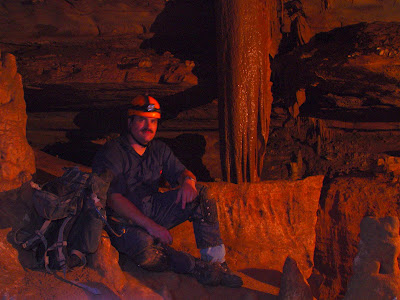ED. COMMENT: This e-mail string followed a trip to Valhalla pit in northeastern Alabama in early 2005. This discussion exposed lore, folklore, ignorance and superstition about rope, gear and techniques for the IRT, and that was just from your Editor.
From: "Matt"
Subject: RE: Pics of the Valhalla Trip
Wow, 4lbs/100ft. that is about half the weight of caving rope. For spectra (UHMWPE) and polyester, try not to get the sheath too hot. If you have a really screaming rappel, get the descender off the rope quickly.
I do wonder how the spectra will hold up to repeated flexing. As I recall it was better than aramids (like Kevlar) but worse than nylon or polyester. Flex fatigue is usually inversely proportional to modulus (stiffness). The high molecular orientation is great for tensile strength, good for modulus, and bad for flex fatigue. Although as Houston mentioned, half of 5000lbs is still a heck of a lot.
From: Shawn
Roy, my rope is: BlueWater Canyon Rope 9.2mm
"A more economical version of the Canyon Pro. 100% polyester sheath. 100% nylon core. The sheath strand design utilizes the same Z/S, S/Z cabled construction as the Canyon Pro. Excellent diameter to strength ratio. Flourescent Orange. Available in 200 and 600 ft. lengths. Tensile Strength: 5000 lbs, safe working load: 333 lbs, weight per 100 ft: 4.03 lbs"
Joe told us that your rope made of the recently declassified military grade Kevlar impregnated with silicon. You bought your rope from the guy, remember. I ordered my rope before the trip.
You think he was making that stuff up? What about the 10.5 megabit SLR just released waterproof canyon camera he was getting? Not that too.
I think your rope is the pro version of mine. 8mm.
From: Andy
The rope that I have is not Kelvar - Shawn's is though I believe. Mine is 100% Spectra 1000 core:
SPECTRA, DYNEEMA & HIGH MODULUS DYNEEMA Spectra is the trade name for a high performance polyethylene (HPPE) fiber manufactured by Allied Signal. Dyneema is manufactured by DSM (Netherlands) and is the same material. Originally introduced in 1985, there are two versions: Spectra 900 and Spectra 1000. The original Spectra 900 has a higher elongation and can not be sewn. The Spectra 1000 was introduced to overcome these drawbacks and is used today for paragliders. The two types of Spectra are the source for the myth "that all Spectra stretches".
From: Matt
I've rappelled 200ft on an eight, on caving rope. Sure it's less safe than a rack, but if you want to be really safe you can watch it on TV.
I think the spiral pattern the poor motion-sick caver behind you leaves on the sides of the pit is fascinating. I tried to do that to Reed once, but he got me back by knocking ice down on me for much of the drop.
Anyway, Dave and Houston are not the final authorities on what is cool. I've seen both of them do stuff that would make your hair curl.
As to the Kevlar rope, I have some experience with some of the high strength filaments - aramids and super-oriented UHMWPE (spectra, dyneema, and others). What I recall as of two or three years ago is that flex fatigue was far worse than nylon, heat resistance was worse as well. Also, the knot strength of a figure eight knot in nylon rope is 70-80%, while for the high strength filaments it was more like 50%. So, especially rappelling with an eight, I would be interested to know how quickly the Kevlar rope lost strength. They could have solved the problems, I haven't kept up with it since I have been out of the industry and almost out of caving and climbing.
From: Shawn
Kirk, you set a new record for bugging out and leaving gear in four states!
Correct that, not gear, disgusting muddy denim artifacts and other stuff. I do have the dirty laundry, on you along with about 15 pounds of gear. B. has already washed your stuff though, so you will be getting it back.
Question: did you have three croll ascenders? a new one and two black ones? are those Matt's? do you want me to deliver all this stuff to Dale along with his Bastard Agitation Cooler? my glove collection grew. any claims can be filed. two homeless biners are being held ransom for a straight swap - anonymous replies accepted.
From: Andy
What are you talking about? I would do it again. Dale got so freaked out about it so I questioned Houston and Dave and both of them told me that it was cool. Besides, this was no standard figure 8. It was a Piranha which has multiple friction points built into it. What did you guys think about the picks I took ON repel?
From: Dale
Joke, what joke?!? He was actually using a figure 8. Probably because I told him not to. Since that's the only guaranteed way to get Roy to do something.
From: William K
I thought the figure 8 joke was pretty funny...
From: Dale
Sent: Thursday, April 07, 2005 7:22 AM
Subject: RE: Pics of the Valhalla Trip
Says HH: I have the joneses to go again...already.
Says I: Neversink!
Great photos, Roy. By the way, I think I'd remove the reference to using a figure 8 on Valhalla Pit.







